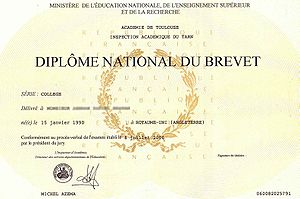
Brevet des collèges
Encyclopedia

The National diploma is a diploma given to French pupils at the end of the (Year 10 / Ninth grade)
Ninth grade
Ninth grade is the ninth post-kindergarten year of school education in some school systems. The students are 13 to 15 years of age, depending on when their birthday occurs. Depending on the school district, ninth grade is usually the first year of high school....
, This diploma is awarded to students that are or were within French
French people
The French are a nation that share a common French culture and speak the French language as a mother tongue. Historically, the French population are descended from peoples of Celtic, Latin and Germanic origin, and are today a mixture of several ethnic groups...
cultural influence, including France itself, Lebanon and Syria, the latter two within the scope of a League of Nations
League of Nations
The League of Nations was an intergovernmental organization founded as a result of the Paris Peace Conference that ended the First World War. It was the first permanent international organization whose principal mission was to maintain world peace...
mandate to France after World War I.
To be awarded a diploma, pupils must acquire the 7 common core skills (socle commun de connaissances et de compétences) and achieve a minimum of 190 points (out of 380). These points are awarded via tests in each subject except in history-geography-civics (le contrôle continu) and in a final exam at the end of ninth grade, also starting from 2008, pupils must acquire the A2
Common European Framework of Reference for Languages
The Common European Framework of Reference for Languages: Learning, Teaching, Assessment, abbreviated as CEFR, is a guideline used to describe achievements of learners of foreign languages across Europe and, increasingly, in other countries...
level of the Common European Framework of Reference for Languages
Common European Framework of Reference for Languages
The Common European Framework of Reference for Languages: Learning, Teaching, Assessment, abbreviated as CEFR, is a guideline used to describe achievements of learners of foreign languages across Europe and, increasingly, in other countries...
in a foreign language (English, German, Spanish, Italian...). In other countries, primarily the UK, US, Canada
Canada
Canada is a North American country consisting of ten provinces and three territories. Located in the northern part of the continent, it extends from the Atlantic Ocean in the east to the Pacific Ocean in the west, and northward into the Arctic Ocean...
, and several ex-Yugoslav
Yugoslavia
Yugoslavia refers to three political entities that existed successively on the western part of the Balkans during most of the 20th century....
and Asia
Asia
Asia is the world's largest and most populous continent, located primarily in the eastern and northern hemispheres. It covers 8.7% of the Earth's total surface area and with approximately 3.879 billion people, it hosts 60% of the world's current human population...
n states, the equivalent period covered by the diploma is middle school
Middle school
Middle School and Junior High School are levels of schooling between elementary and high schools. Most school systems use one term or the other, not both. The terms are not interchangeable...
.
Continuous assessment
Over the course of the troisième, after each chapter of a lesson is completed, all pupils take a test out of twenty. The marks from these tests are stored on a database at the school's academy and at the school itself (to prevent data loss) and at the end of each trimester the average mark from each subject is calculated as well as a general average (the average of all the subjects' averages).Up until 2007 the averages from the two school years (six trimesters) from the start of the quatrième to the end of the troisième were counted towards the final result. From 2007 onwards, only the marks from the troisième are used. It is possible for a pupil to know he has a good enough average to pass the Brevet before sitting the exams, however they cannot elect not to attempt the exams, as this would mean automatic disqualification.
Final exam
At the end of the troisième, three tests are taken, in order such that each has a score of:French: 40
History, geography and citizenship: 40
Mathematics: 40
And as of 2011 an oral exam in cultural history ("histoire des arts") is mandatory for all students in the troisième. It is taken before before the three other tests. It consists of writing an essay (around 2000 words) about any art form and analyzing 6 to 8 paintings, then presenting them to two teachers (at least one history teacher) for 10-15 minutes then answering questions that they ask. This also has a score out of 40.
Calculation
The results are calculated using a weighted total. The subjects of the final exams are weighted as follows:- French: 2
- Mathematics: 2
- History, Geography and Civic Education: 2
The subjects studied in the troisième (le contrôle continu) are given a total weighting of between 9 and 11, depending on the série taken. In order to pass the Brevet, the pupil must score on average the equivalent of 10 out of 20. A higher score may result in the award of a "mention":
- 10 to 12: pass
- 12 to 14: satisfactory ("assez bien")
- 14 to 16: good ("bien")
- 16 or above: excellent ("très bien")

